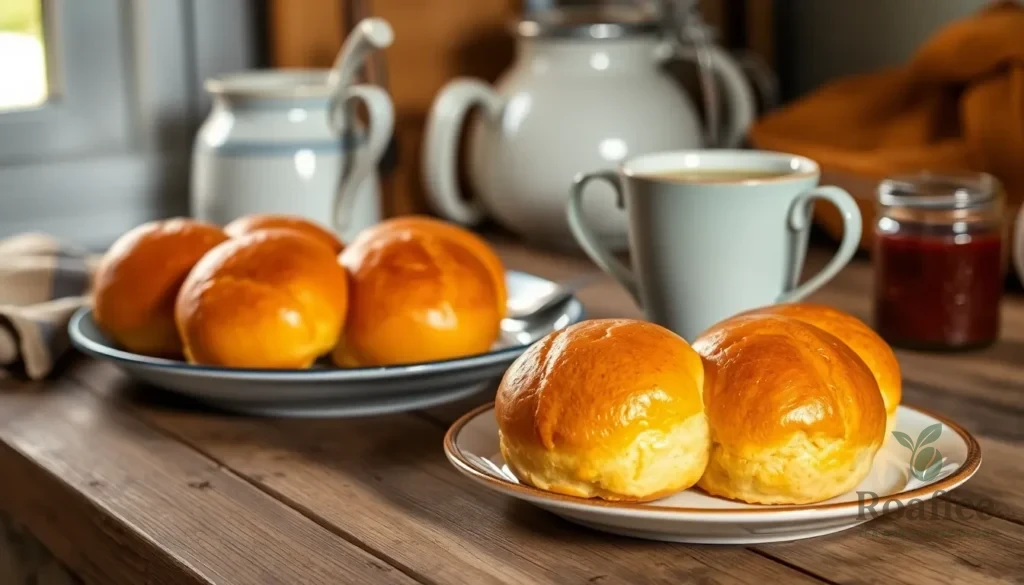We can’t think of anything more comforting than warm, fluffy tea buns fresh from the oven. These delightfully sweet treats have been a beloved staple in British and Irish households for generations, perfectly designed to accompany your afternoon tea or morning coffee. Unlike their richer cousin the scone, tea buns strike the perfect balance between cake and bread with their tender crumb and subtle sweetness.
What makes our tea buns truly special is their incredible versatility. We love how they can be enjoyed plain with a pat of butter, or dressed up with currants, sultanas, or even a drizzle of honey. They’re also surprisingly simple to make, requiring just basic pantry ingredients that you likely already have on hand.
Whether you’re hosting a proper tea party or simply craving something homemade and wholesome, these tea buns deliver every time. They freeze beautifully too, making them perfect for meal prep or unexpected guests.
Ingredients
These simple pantry staples transform into tender, delicious tea buns that pair perfectly with your favorite afternoon brew. We’ve organized the ingredients by component to make preparation seamless and efficient.
For the Dough
- 4 cups all-purpose flour, sifted
- 1/2 cup granulated sugar
- 2 teaspoons active dry yeast
- 1 teaspoon salt
- 1/2 cup whole milk, warmed to 110°F
- 1/4 cup unsalted butter, melted and cooled slightly
- 2 large eggs, room temperature
- 1/2 cup warm water (110°F)
- 1 tablespoon honey
For the Filling
- 1/2 cup dried currants or raisins
- 1/4 cup brown sugar, packed
- 1 teaspoon ground cinnamon
- 2 tablespoons unsalted butter, softened
- 1/4 teaspoon vanilla extract
- Pinch of nutmeg
For the Egg Wash
- 1 large egg
- 2 tablespoons whole milk
- 1 tablespoon granulated sugar for sprinkling
Equipment Needed
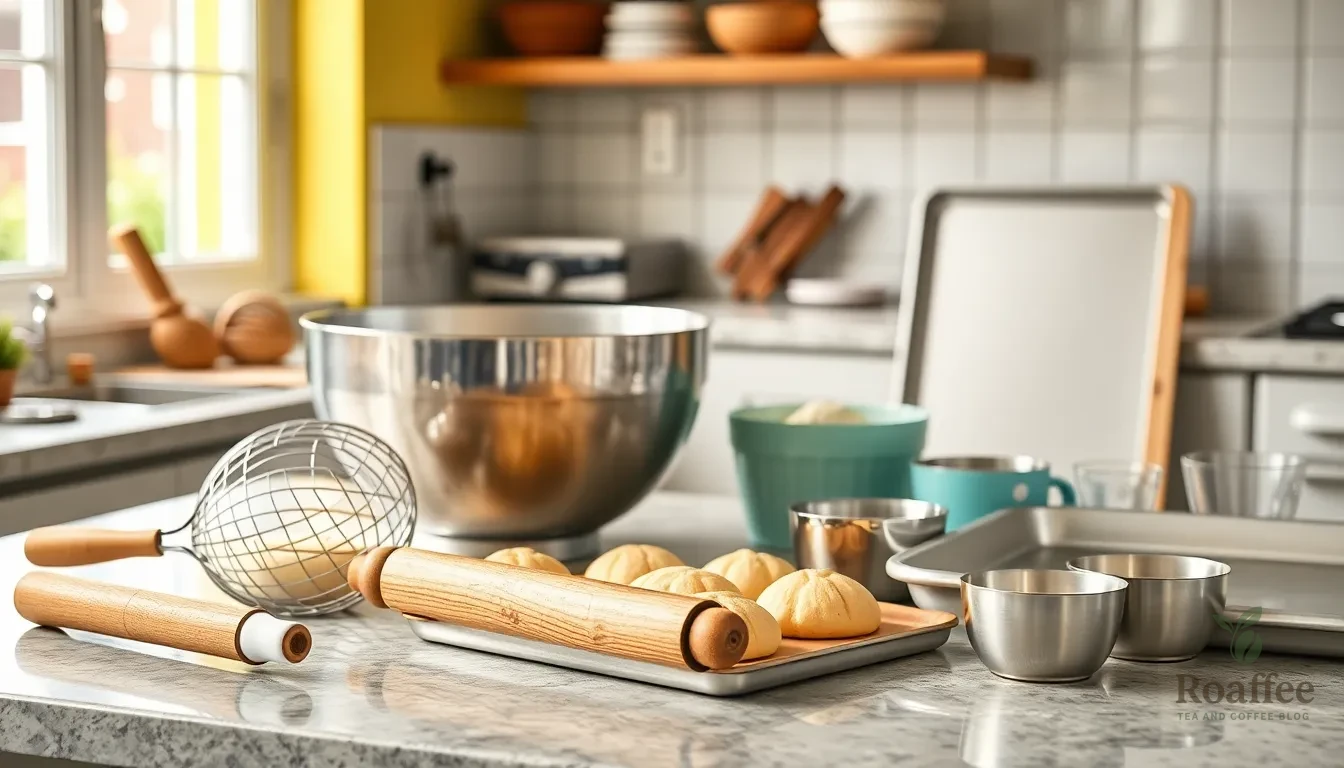
Having the right tools makes all the difference when preparing our traditional tea buns. We recommend gathering these essential items before starting to ensure a smooth baking process.
Mixing and Preparation Tools
- Large mixing bowl for combining dry ingredients
- Food processor (optional but speeds up butter incorporation)
- Pastry blender or knife for cutting cold butter into flour
- Small bowl for soaking raisins
- Measuring cups and spoons for accurate ingredient portions
Rolling and Shaping Equipment
- Rolling pin to achieve the perfect 1 to 1.5 inch thickness
- 3-inch biscuit cutter or cookie cutter for uniform rounds
- Clean kitchen towel to keep dough covered while working
Baking Essentials
- Aluminum baking sheet for optimal heat distribution
- Parchment paper or non-stick spray to prevent sticking
- Pastry brush for applying egg wash glaze
- Wire cooling rack for proper air circulation
Oven Requirements
We need to preheat our oven to 375°F (190°C) before beginning the mixing process. This temperature ensures our tea buns develop that perfect golden brown exterior while maintaining their soft, tender interior.
Most home bakers already own these common kitchen tools. The aluminum baking sheet proves particularly important because it distributes heat evenly and prevents our buns from spreading during baking. We also find that using parchment paper makes cleanup effortless while ensuring our buns release easily from the pan.
Instructions
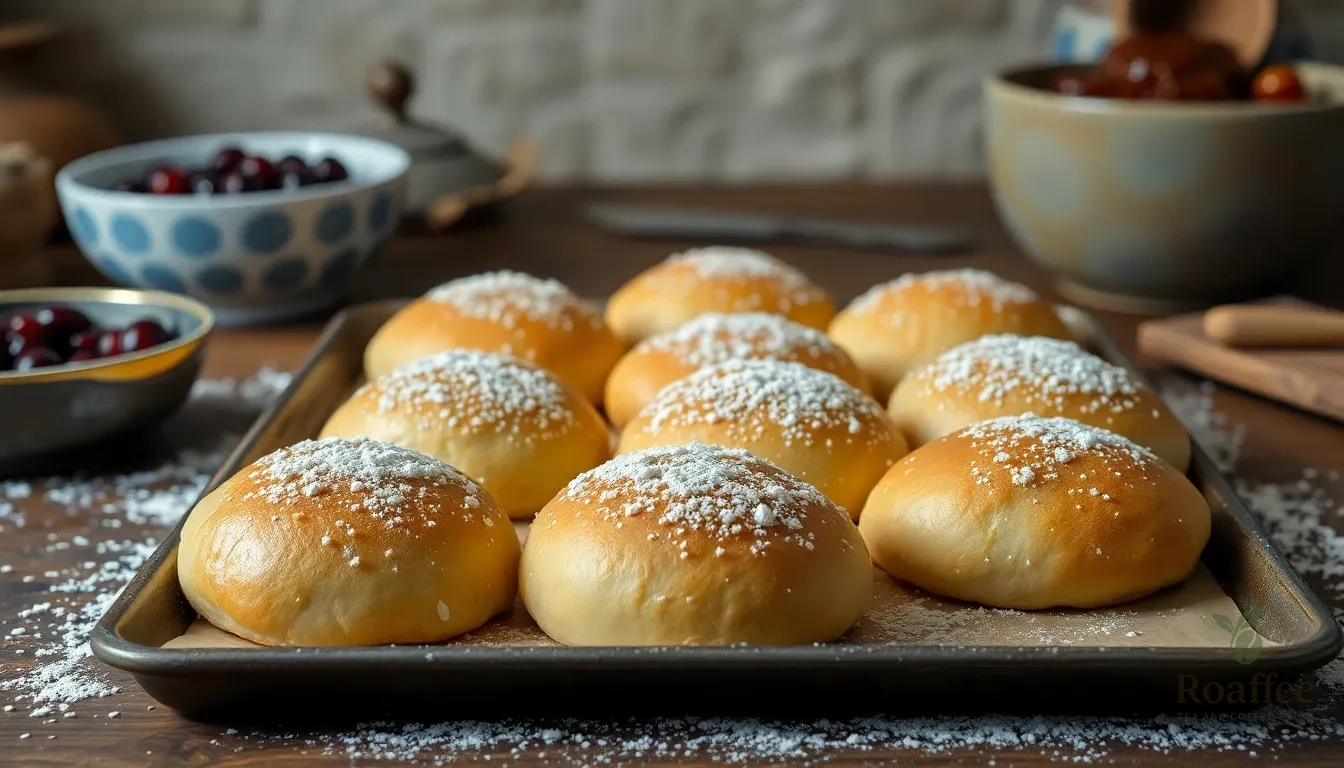
Follow these step-by-step instructions to create perfectly fluffy tea buns that will become your go-to comfort treat. We’ll guide you through each stage from preparing the dough to achieving that golden brown finish.
Prep the Dough
Combine 3 cups all-purpose flour, ¾ cup granulated sugar, 4 teaspoons baking powder, and ½ teaspoon salt in our large mixing bowl. Cut the cold unsalted butter into small cubes and add to the dry ingredients. Use your fingers or a pastry cutter to work the butter into the flour mixture until it resembles coarse crumbs with some pea-sized pieces remaining.
Whisk together the warmed whole milk, room temperature egg, and vanilla extract in a separate bowl. Pour this liquid mixture into the flour mixture and gently stir with a wooden spoon until the dough just comes together. Avoid overmixing to maintain the tender texture that makes these buns so special.
Turn the soft dough onto a lightly floured surface and gently knead 2-3 times until it forms a cohesive ball. The dough should feel soft and slightly sticky but manageable.
Make the Filling
Combine the dried currants or raisins with 2 tablespoons brown sugar and 1 teaspoon ground cinnamon in a small bowl. Add the softened unsalted butter, vanilla extract, and a pinch of nutmeg to create a fragrant filling mixture.
Stir the ingredients together until they form a spreadable consistency. This sweet filling will create pockets of flavor throughout each bun while they bake.
Shape the Buns
Roll the dough on a lightly floured surface to approximately 1 to 1½ inches thick. Use a biscuit cutter or round glass to cut the dough into circles, or shape them by hand for a more rustic appearance.
Place a small spoonful of the filling mixture in the center of each dough round. Gently bring the edges together and pinch to seal, then roll between your palms to create smooth, round buns. Arrange the shaped buns on our parchment-lined aluminum baking sheet, leaving about 2 inches between each one.
Let Rise
Allow the shaped buns to rest at room temperature for 30 minutes to 1 hour until they have doubled in size. This crucial rising period ensures our tea buns will be fluffy and light rather than dense.
Cover the buns with a clean kitchen towel during this time to prevent them from drying out. The buns are ready when they spring back slowly when gently pressed with your finger.
Bake the Tea Buns
Preheat your oven to 375°F (190°C) while the buns complete their final rise. Whisk together the egg, milk, and granulated sugar to create the egg wash that will give our buns their beautiful golden finish.
Brush the tops of each bun with the egg wash using a pastry brush. Bake for 15-25 minutes or until the tops are golden brown and the buns sound hollow when tapped on the bottom.
Remove from the oven and let cool on the baking sheet for 5 minutes before transferring to a wire rack. Serve warm or at room temperature for the best texture and flavor.
Directions for Serving
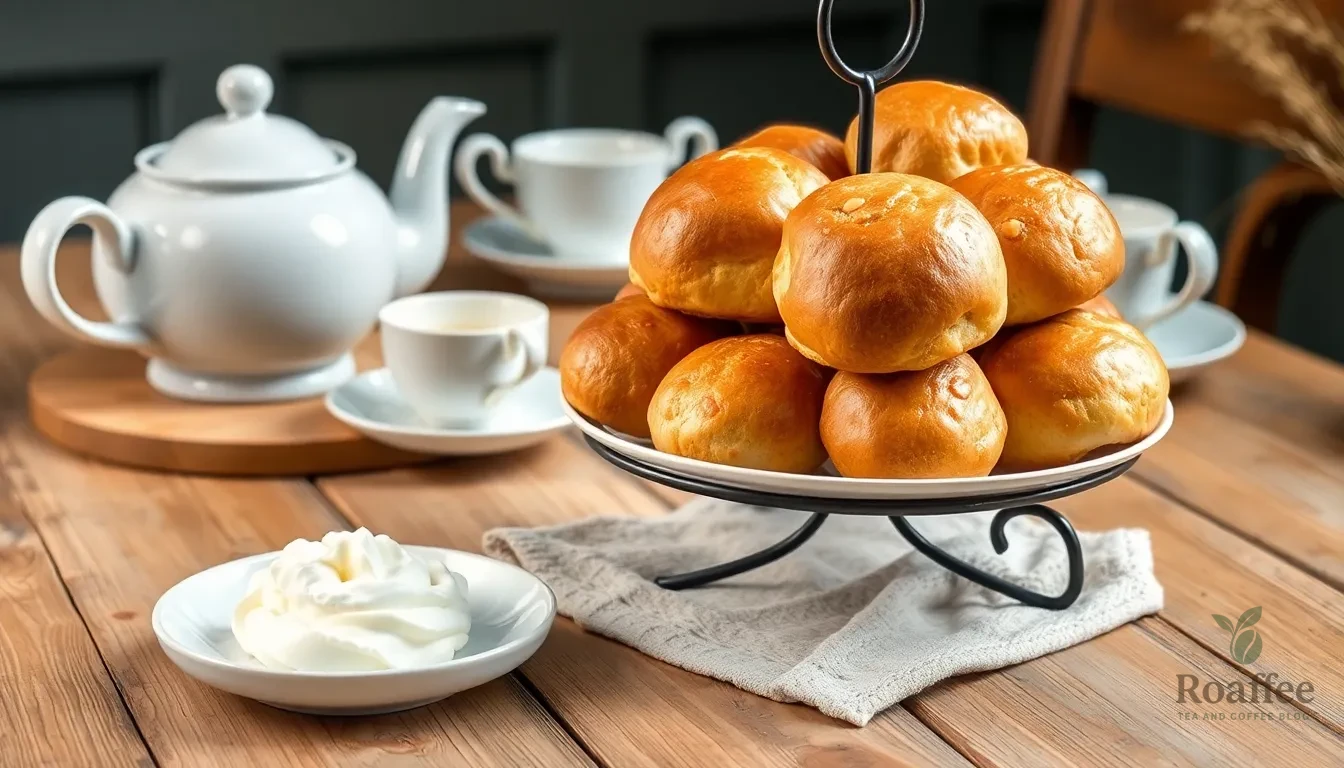
We recommend serving our freshly baked tea buns warm for the ultimate comfort experience. The gentle heat releases their delicate aroma while maintaining that perfect tender crumb we worked so hard to achieve.
Temperature Options:
- Serve warm straight from the oven for maximum flavor
- Allow cooling to room temperature for a more traditional presentation
- Reheat gently in a 300°F oven for 5 minutes if buns have cooled completely
Classic Accompaniments:
We love pairing these versatile buns with simple spreads that complement their subtle sweetness. Fresh butter melts beautifully into the warm crumb while homemade jam adds a delightful fruity contrast. For tea time service we suggest arranging the buns on a tiered stand alongside clotted cream and preserves.
Beverage Pairings:
Tea buns shine brightest when served alongside a proper cup of tea. Earl Grey provides citrusy notes that enhance the buns’ vanilla undertones. English Breakfast tea offers robust flavor that balances the sweetness perfectly. Coffee enthusiasts will find these buns pair wonderfully with medium roast blends.
Savory Variations:
Transform your tea buns into heartier fare by adding savory elements. We recommend slicing them horizontally and filling with thinly sliced cheese for a satisfying snack. Ham and cheese combinations create an excellent lunch option that showcases the buns’ versatility.
Presentation Tips:
Arrange your tea buns on a clean kitchen towel to maintain warmth during serving. This traditional method keeps them soft while allowing excess moisture to escape. For special occasions dust lightly with powdered sugar just before presenting to your guests.
Make-Ahead Instructions

Planning ahead transforms tea bun baking from a time-consuming task into a convenient treat ready whenever we need it. We can prepare these delightful buns up to several days in advance using proven make-ahead techniques that maintain their signature soft texture and rich flavor.
Preparing and Storing Unbaked Dough
We recommend shaping our tea bun dough completely before storing it for future baking. After rolling the dough to 1-inch thickness and cutting into rounds, we place the shaped buns on aluminum baking trays lined with parchment paper. Cover the trays with oiled plastic wrap to prevent the dough from drying out and creating a tough exterior.
Refrigerated dough stays fresh for up to 24 hours and requires minimal preparation before baking. For longer storage, we can freeze the shaped buns for up to three months. Wrap each tray tightly with plastic wrap, then aluminum foil to prevent freezer burn and maintain optimal texture.
Baking Make-Ahead Dough
Refrigerated tea bun dough needs about 30 minutes at room temperature before baking to ensure even cooking. We allow the dough to lose its chill while preheating our oven to 375°F (190°C). This temperature consistency prevents the exterior from browning too quickly while the interior remains undercooked.
Frozen dough requires a different approach for best results. We transfer frozen buns to the refrigerator 8-12 hours before baking, allowing them to thaw gradually. Once thawed, we follow the same 30-minute room temperature rest before applying egg wash and baking for the standard 20-25 minutes until golden brown.
Advance Preparation Tips
Real butter remains crucial for make-ahead success as it prevents the sticky dough issues that can develop during storage. We flour our work surface generously when initially shaping the dough and handle it minimally to maintain the tender crumb structure that tea buns are known for.
Baking times may vary slightly for make-ahead dough, particularly if the buns are slightly smaller or larger than standard size. We monitor the buns carefully during the final 5 minutes of baking to achieve that perfect golden brown color without overbaking.
Finishing Touches for Make-Ahead Buns
Glacé icing can be prepared simultaneously with our make-ahead buns for a complete finishing touch. We melt butter into sugar and water, creating a smooth drizzle that we apply to cooled buns. Topping with coconut adds both texture and flavor that complements the subtle sweetness of our tea buns perfectly.
Storage Tips

Fresh tea buns deserve proper storage to maintain their soft texture and delightful flavor. We’ve discovered that the right storage method can extend your tea buns’ freshness for days or even weeks.
Room Temperature Storage
Store your freshly baked tea buns at room temperature for optimal taste and texture. Cover them completely with aluminum foil, plastic wrap, or place them in a sealed plastic bag. This method keeps our tea buns fresh for 1 to 2 days while preserving their tender crumb.
An airtight container or tin works exceptionally well for preventing moisture loss. We recommend avoiding refrigeration unless absolutely necessary, as cold temperatures can make the buns stale or hard.
Refrigerator Storage
When you need longer storage, place your tea buns in the refrigerator where they’ll stay fresh for up to 1 week. Wrap each bun individually in plastic wrap or store them together in an airtight container. This method works particularly well for tea buns with perishable fillings or during warm weather.
Freezing for Extended Storage
Freezing offers the best long-term storage solution for our tea buns. Wrap each bun tightly in plastic wrap, then place them in a freezer-safe bag or container. Properly stored tea buns maintain their quality for 2 to 3 weeks in the freezer.
| Storage Method | Duration | Best For |
|---|---|---|
| Room Temperature | 1-2 days | Immediate consumption |
| Refrigerator | Up to 1 week | Medium-term storage |
| Freezer | 2-3 weeks | Long-term storage |
Freezing Unbaked Dough
Raw cut dough freezes beautifully for future baking convenience. Place the shaped unbaked tea buns on a tray and freeze them until solid. Transfer the frozen dough pieces to a freezer bag for storage. Bake directly from frozen without defrosting, adding just a few extra minutes to the original baking time.
Reheating Tips
Thaw frozen tea buns at room temperature for about 30 minutes before serving. For the best texture, warm them briefly in a 300°F oven for 5 to 8 minutes. This gentle reheating restores their original softness and brings back that fresh-baked aroma we all love.
Variations

Our tea buns adapt beautifully to countless flavor combinations and dietary preferences. These versatile treats transform from simple afternoon snacks to impressive desserts or satisfying savory options with just a few ingredient swaps.
Sweet Tea Buns
Sweet tea buns offer endless possibilities for creating delightful treats that complement any tea service. We love adding plump raisins that have been soaked in warm water for 10 minutes to soften their texture before folding them into the dough. The Newfoundland Raisin Buns remain a classic favorite, enhanced with butter, sugar, lemon juice, vanilla, and evaporated milk for authentic flavor.
Coconut lovers will appreciate our Coconut Tea Buns variation, where we incorporate 1/2 cup of shredded coconut directly into the dough or press it onto the surface before baking. The coconut adds tropical sweetness and creates an appealing golden exterior when baked.
For a citrusy twist, Mandarin Tea Buns incorporate segments of mandarin oranges that provide natural sweetness and moisture. We drain the fruit thoroughly and fold it gently into the dough to prevent excess liquid from affecting the texture.
| Sweet Variation | Key Ingredients | Baking Time |
|---|---|---|
| Raisin Buns | Soaked raisins, vanilla, lemon juice | 20-25 minutes |
| Coconut Buns | Shredded coconut, butter | 15-20 minutes |
| Mandarin Buns | Mandarin segments, reduced sugar | 18-22 minutes |
Savory Tea Buns
Savory tea buns transform our basic recipe into hearty snacks perfect for lunch or dinner accompaniments. We reduce the sugar content significantly and emphasize egg richness to create a more substantial texture that complements savory fillings.
Our Cheese Tea Buns incorporate 1 cup of shredded cheese directly into the dough mixture, creating pockets of melted goodness throughout each bun. Sharp cheddar works exceptionally well, though we also enjoy experimenting with gruyere or aged white cheddar for deeper flavor profiles.
The Ham and Cheese combination elevates these buns to meal status. We dice 1/2 cup of quality ham and combine it with 3/4 cup of shredded cheese, distributing the mixture evenly throughout the dough. These buns benefit from an egg wash brushed on top before baking, creating a glossy, golden finish.
Sea salt becomes more prominent in savory versions, and we often add 1/4 teaspoon of garlic powder or dried herbs like thyme or rosemary to enhance the flavor complexity. Cold butter remains essential for achieving the proper texture, and we maintain the same mixing technique to avoid overworking the dough.
| Savory Variation | Key Ingredients | Special Notes |
|---|---|---|
| Cheese Buns | 1 cup shredded cheese, reduced sugar | Egg wash recommended |
| Ham and Cheese | 1/2 cup diced ham, 3/4 cup cheese | Brush with egg wash |
| Herb Buns | Fresh herbs, garlic powder, sea salt | Add herbs to dry ingredients |
Troubleshooting Tips
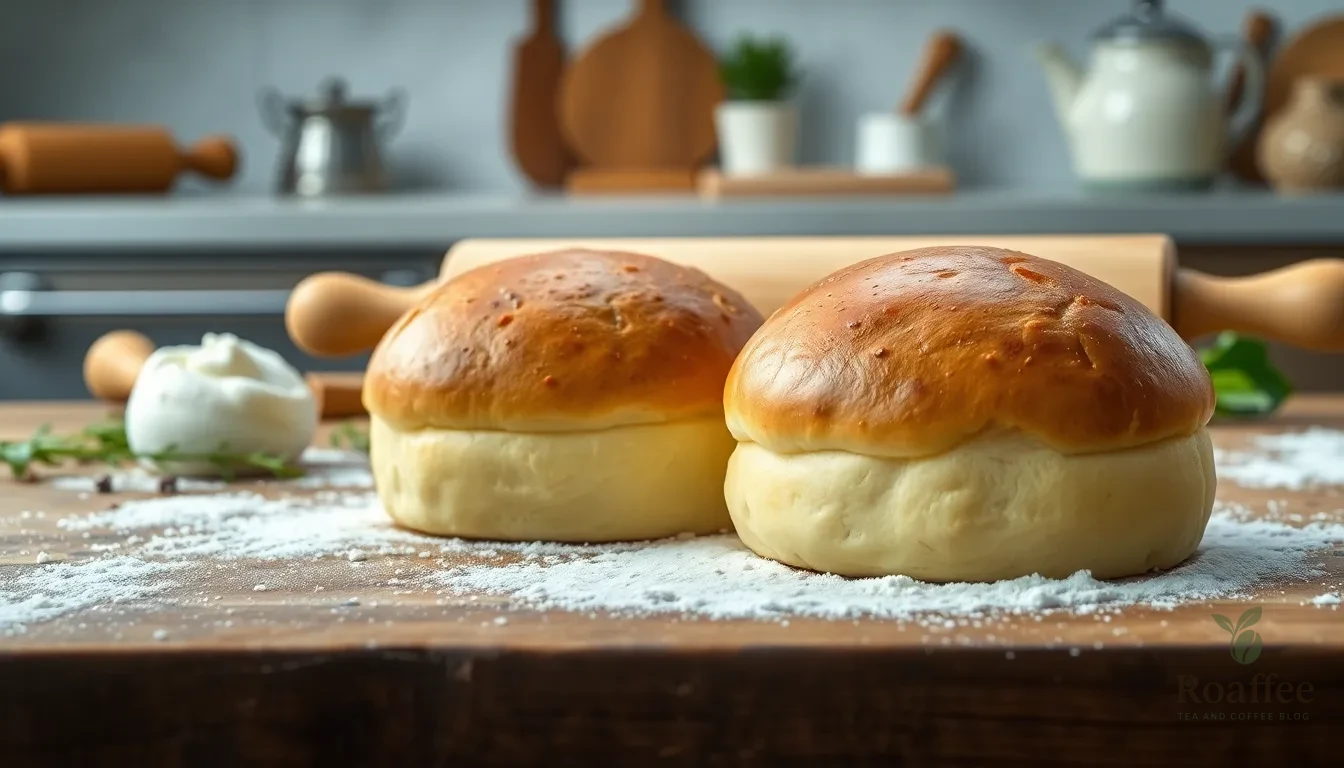
Even experienced bakers encounter challenges when making tea buns. We’ve compiled essential answers to common problems that ensure your buns turn out perfectly every time.
Dense or Heavy Texture
Problem: Tea buns that turn out dense instead of light and fluffy typically result from overworking the dough or using the wrong butter temperature.
Solution: Use only real butter in its proper form – cold butter for cutting into flour creates the ideal texture. Substitutes cause sticky dough and compromise the final result. Mix ingredients just enough to combine without overworking the dough.
Poor Rising Issues
Problem: Buns that don’t rise properly or remain flat during baking often indicate temperature or timing problems.
Solution: Ensure your dough rises in a warm place for the full duration – typically twice for about 1 hour each rise. Insufficient rising leads to crusty buns rather than the desired soft texture. Check that your yeast is active if using a yeast-based recipe.
Shape and Cutting Problems
Problem: Buns that spread too much or don’t maintain their shape during baking.
Solution:
| Issue | Solution |
|---|---|
| Thin dough | Don’t roll dough thinner than 1 inch – thicker buns rise better and stay soft |
| Twisted cuts | Avoid twisting biscuit cutters when shaping buns as this inhibits rising |
| Wrong pan | Use aluminum pans rather than steel to prevent excessive spreading |
Surface and Appearance Issues
Problem: Buns with uneven browning or overly dark tops affect both appearance and taste.
Solution: Apply egg wash carefully – thick application or adding sugar on top can lead to darker surfaces. Preheat your oven thoroughly to 375°F (190°C) for consistent results. Monitor baking time closely as tea buns typically need 15-25 minutes until golden brown.
Dough Handling Difficulties
Problem: Sticky dough that’s difficult to work with or shape properly.
Solution: Well-flour your work surface and the top of your dough but avoid adding too much flour during mixing. Keep butter cold throughout the process and handle the dough gently. The mixture should have a coarse meal texture after cutting in butter.
Texture Consistency Problems
Problem: Buns that turn out too dry or too wet affect the overall eating experience.
Solution: Measure ingredients accurately and add wet ingredients gradually. The dough should be soft but not sticky. Add milk or liquid ingredients slowly until you achieve the right consistency for shaping.
Conclusion
We’ve shared everything you need to create these delightful tea buns that’ll become a staple in your kitchen. With our straightforward recipe and detailed guidance you’re equipped to bake perfect buns every time.
The beauty of tea buns lies in their adaptability – whether you prefer sweet currants or savory cheese fillings there’s a variation that’ll suit your taste. Our make-ahead tips and storage methods ensure you can enjoy fresh buns whenever the craving strikes.
Remember that baking is about practice and patience. Don’t worry if your first batch isn’t perfect – use our troubleshooting guide to refine your technique and soon you’ll be creating bakery-quality tea buns that’ll impress family and friends alike.
Frequently Asked Questions
What are tea buns and how do they differ from scones?
Tea buns are warm, fluffy treats that offer a delightful balance between cake and bread, featuring a tender crumb and subtle sweetness. Unlike scones, tea buns have a softer, more cake-like texture while maintaining some bread-like qualities. They’re a cherished treat in British and Irish households and can be enjoyed plain or with various additions like currants or honey.
What ingredients do I need to make tea buns?
For the dough, you’ll need all-purpose flour, granulated sugar, active dry yeast, salt, warm whole milk, melted butter, eggs, warm water, and honey. For the filling, gather dried currants or raisins, brown sugar, cinnamon, softened butter, vanilla extract, and nutmeg. An egg wash requires one egg, milk, and sugar for a beautiful golden finish.
What equipment is essential for making tea buns?
You’ll need basic mixing tools including a large mixing bowl, food processor, and measuring cups. For shaping, gather a rolling pin and biscuit cutter. Essential baking equipment includes an aluminum baking sheet and parchment paper. Don’t forget to preheat your oven to 375°F (190°C) for optimal results.
How do I prepare and bake tea buns?
Start by combining dry ingredients and incorporating cold butter until it resembles coarse crumbs. Add the milk mixture to form a soft dough, then knead briefly. Roll out the dough, add filling, shape into rounds, and let rise until doubled. Apply egg wash and bake until golden brown for perfect results.
What are the best ways to serve tea buns?
Serve tea buns warm for enhanced aroma and texture. Classic accompaniments include fresh butter, homemade jam, clotted cream, and preserves. Pair with Earl Grey or English Breakfast tea, or even coffee. For variety, try savory fillings like cheese or ham, and dust with powdered sugar for special occasions.
Can I make tea buns ahead of time?
Yes! Shape the dough in advance and refrigerate for up to 24 hours or freeze for up to three months. Allow refrigerated dough to rest at room temperature before baking. Frozen dough should thaw completely before use. This makes tea buns perfect for meal prep or unexpected guests.
How should I store tea buns to maintain freshness?
Store tea buns at room temperature covered with foil or plastic wrap for 1-2 days. Refrigerate for up to a week for longer storage. For long-term storage, freeze for 2-3 weeks. You can also freeze unbaked dough for future convenience. Reheat gently to restore original softness and aroma.
What flavor variations can I try with tea buns?
Sweet variations include soaked raisins, shredded coconut, or mandarin segments. Savory options feature cheese, ham and cheese, or herb-infused combinations. Each variation offers unique flavors and textures while maintaining the basic tea bun recipe structure. Adjust baking times slightly depending on your chosen ingredients.
What are common tea bun baking problems and solutions?
Dense texture often results from overworking dough or incorrect butter temperature. Poor rising indicates yeast issues or inadequate proofing conditions. Shape problems come from dull cutters or overworked dough. Surface issues relate to improper egg wash application. Always use real butter, monitor temperatures, and avoid overhandling the dough.
How long do tea buns take to bake and at what temperature?
Bake tea buns at 375°F (190°C) until golden brown. Fresh dough typically takes 15-20 minutes, while refrigerated dough may need slightly longer. Frozen dough should be thawed completely before baking. Monitor closely during the final minutes to achieve the perfect golden exterior while maintaining a soft, tender interior.

